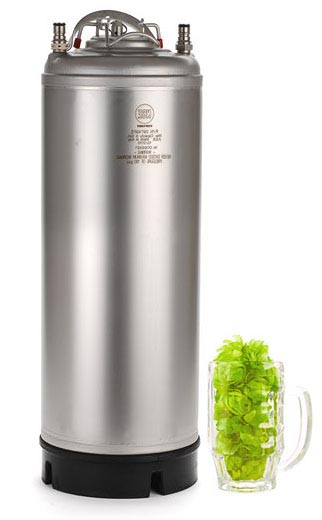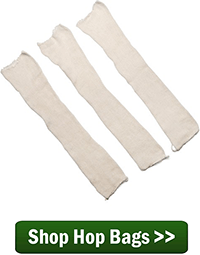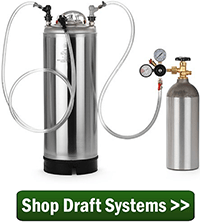 Though you can certainly dry hop during secondary fermentation, some homebrewers prefer dry hopping in a keg. This is similar to what British brewers do when they dry hop in the cask. Dry hopping can enhance the hop aromas in your beer, but how do you do it without clogging the keg? What is the most sanitary procedure for dry hopping in a keg of homebrew?
Though you can certainly dry hop during secondary fermentation, some homebrewers prefer dry hopping in a keg. This is similar to what British brewers do when they dry hop in the cask. Dry hopping can enhance the hop aromas in your beer, but how do you do it without clogging the keg? What is the most sanitary procedure for dry hopping in a keg of homebrew?
It’s really quite easy. First, gather the following:
- Hops – Low alpha acid hops are popular for dry hopping, though some high alpha hops are suitable as well. You might consider matching whatever flavor and/or aroma hop addition you used in the beer. If you’ve never dry hopped before, an ounce of hops is a good place to start.
- A small straining bag – This is to hold the hop material and keep it from spreading all throughout your keg of beer.
- A small stainless steel or glass item to be used as a weight – A few marbles are perfect; a shot glass can work too.
- Optional: A length of string or non-flavored dental floss – Some homebrewers like to keep the hops from sinking all the way to the bottom of the keg or like to remove them after a certain number of days.
Then just follow the steps below!
Steps For Dry Hopping In A Keg
- Sanitize everything (except the hops). I prefer to boil the bag, the weight, and the string for about twenty minutes. At this point, I’d rather get sterile
 water in the beer than sanitizer solution. Whether or not you should sanitize the hops is debatable. I choose not to because 1) Most hops you get will be nitrogen flushed and frozen, 2) hops have antimicrobial properties, and 3) beer has alcohol in it. If you feel your hops are suspect or you’re dry hopping a very low alcohol beer, you might consider gently steaming the hops for a few minutes before using them to dry hop your keg.
water in the beer than sanitizer solution. Whether or not you should sanitize the hops is debatable. I choose not to because 1) Most hops you get will be nitrogen flushed and frozen, 2) hops have antimicrobial properties, and 3) beer has alcohol in it. If you feel your hops are suspect or you’re dry hopping a very low alcohol beer, you might consider gently steaming the hops for a few minutes before using them to dry hop your keg.
- Put the hops and the weight in the bag and tie it closed. Make sure to tie the bag well so the hops don’t come out and get everywhere.
- Optional: Tie the string to the bag and secure it to the keg. If you’d like, you can suspend the hop bag about halfway down the keg, tying the other end to the handle of the keg. The idea is that you can limit the amount of time the hops are in your beer. As you drink the beer and the level in the keg goes down, the hops will eventually be suspended from the string. Using something as thin as dental floss will allow you to seal the keg without any leaks.
- Drop the bags of hops in the keg. Turn off the CO2 at the regulator and fully vent the keg to release pressure. Open the lid and gently drop the bag in the beer.
 Apply pressure to the keg and proceed as normal! You may wish to vent the keg a couple times to eliminate any air that got in.
Apply pressure to the keg and proceed as normal! You may wish to vent the keg a couple times to eliminate any air that got in.
That’s it! That’s all there is to dry hopping in a keg. Now enjoy the delectable hop aromas in your homebrew!
————————————
David Ackley is a beer writer, brewer, and self-described “craft beer crusader.” He holds a General Certificate in Brewing from the Institute of Brewing and Distilling and is founder of the Local Beer Blog.
